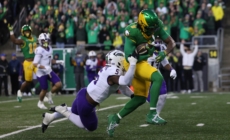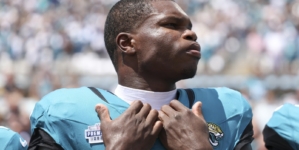-
Honduras Declares Nasry Asfura, Trump Ally, Winner of Presidential Election - 28 mins ago
-
Trump Tosses Lifelines to the Struggling Coal Industry - about 1 hour ago
-
Dog Surrendered to Shelter Just Before Christmas—Reason Breaks Hearts - about 1 hour ago
-
The Strange Death of Make America Great Again - 2 hours ago
-
Latest Travis Hunter Injury Update a Great Sign for Jaguars Fans - 3 hours ago
-
How Service Dogs Help Treat Veterans’ PTSD - 3 hours ago
-
In Private Letters, Harvard and Trump Administration Escalate Duel - 3 hours ago
-
NFL Dominates College Football Playoff in Ratings Battle - 4 hours ago
-
Magnitude 2.6 earthquake reported off Malibu - 4 hours ago
-
How a Scholar Nudged the Supreme Court Toward Its Troop Deployment Ruling - 4 hours ago
Starbucks union launches strike in dozens of stores on Red Cup Day

The union representing Starbucks baristas launched an open-ended strike at stores in more than 40 cities on Thursday, coinciding with Red Cup Day, one of the coffee giant’s most lucrative sales days of the year.
The union, Starbucks Workers United, said the strike involved more than 1,000 baristas in some 65 stores as of Thursday morning, but threatens to spread to more locations if contract talks that have dragged on for years do not progress.
The unionized workers say they are striking for better take-home pay, more predictable scheduling and to resolve hundreds of unfair labor practice charges workers have filed against the company with federal regulators in recent years.
“We’re striking to fight back,” Jeremiah Pettus, a barista at the Starbucks location at Downtown Disney in Anaheim, said in an emailed statement. “Starbucks knows where we stand. They know our demands. The ball is in their court.”
The Downtown Disney store launched its strike days earlier than other locations, on Nov. 8, as a result of tensions flaring between management and the unionized workers, the union said. It declined to detail what specifically prompted the early action.
The strike so far involves about 10 California stores, including locations in Anaheim, Long Beach, San Diego, Santa Clarita, Santa Cruz, Scotts Valley, Seal Beach and Soquel, according to the union.
Although Starbucks said its operations are seeing minimal impact, the action could hinder business during Starbucks’ busy holiday season. The company is probably relying on that sales spike to improve its performance under Chief Executive Brian Niccol, who took the helm last year.
The company has struggled in recent years, with multiple changes in leadership, softening demand and boycotts over its perceived support for Israel. But in its most recent quarterly earnings, the company posted a 1% increase in global same-store sales, ending a two-year streak of declines. Sales at U.S. stores remained flat, however.
“We still have a lot of work in front of us, but it’s clear we’re moving in the right direction,” Niccol said during a recent call with investors.
On Thursday, Starbucks spokesperson Jaci Anderson said 99% of the company’s locations across the U.S. were unaffected by the strike.
“The day is off to an incredible start — based on what we’ve seen this morning, we’re on track to exceed our sales expectations for the day across company-operated coffeehouses in North America,” Anderson wrote in an email.
On the company’s marketed Red Cup Day, customers who order a holiday-themed beverage, such as the popular pumpkin spice latte, receive a free limited-edition reusable red cup.
The action comes after unionized workers voted last week to authorize a strike, a move that drew approval from 92% of those who voted, according to the union.
After a wave of organizing at Starbucks stores took the U.S. by storm in late 2021, the company launched a robust opposition campaign, drawing hundreds of allegations of misconduct by workers. Federal regulators repeatedly found Starbucks had violated labor laws by disciplining and firing workers involved in unionizing activity, shutting down stores and stalling contract negotiations.
Early last year, however, the company changed its tune, pledging to work with the union. But talks broke down again last winter, and negotiations have remained at a standstill for more than six months.
John Logan, the director of labor and employment studies at San Francisco State University, said that while the company’s previous Chief Executive Laxman Narasimhan made strides toward good relations with the union, Niccol by stark contrast “does not appear to be particularly interested in making a deal.”
Starbucks Workers United says it represents 12,000 workers at about 650 coffee shops. The company disputes the union’s numbers, saying it represents approximately 9,500 workers in 550 shops, or about 4% of Starbucks’ U.S. workforce.
The coffee chain is now taking a more aggressive tack in its public messaging against the union, with Anderson, the company spokesperson, implying without evidence that the union staged picket lines only with paid union staffers rather than actual baristas.
The union said in a statement that Starbucks’ claims that it requested pay increases of 65% — raises its executives characterized as an unrealistic demand — were “incorrect and outdated,” saying the company was improperly lumping together various economic proposals from the union to arrive at those figures.
Todd Vachon, an assistant professor at the Rutgers School of Management and Labor Relations, said that although only a fraction of Starbucks locations are unionized, the strike may still have high visibility, particularly since retail and service industries depend on the relationship between employees and customers.
“That makes shaming a potentially powerful weapon in the union’s arsenal,” Vachon wrote in an email.
The union has previously sought to leverage the busy holiday season, launching a five-day work stoppage in the lead-up to last Christmas Eve.
Michelle Eisen, a former Starbucks employee and a spokesperson for the union, said disrupting Red Cup Day was “just the beginning.”
“If Starbucks continues to stonewall union baristas, we are prepared to make this the largest, longest strike in company history during the critical holiday season,” she said during a Thursday news conference.
Source link















